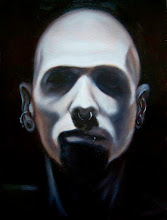As you probably know by now, I enjoy dabbling in "fine" arts now and then. Nothing works better to boost up one's mood than a solvent high. I recently made a quick little painting of Cthulhu, and I thought I'd show you how I usually paint.
My art studio, AKA the floor of my 1 bedroom flat.
Following the jump, I'll show you pictures from each step/sitting with an explanation for what I'm doing. Keep in mind though that it is in no way intended to be a tutorial, but simply a way for me to present the methods I've developed through trial and error in order to achieve somewhat satisfying results. Oils are still a mysterious and frustrating medium for me, though, but y'know, practice makes perfect.
I still have lots of practice to go, that being said!
I started out with a cheap, store-bought stretched cotton canvas, 16'' x 16'' in size. I normally dislike the rough texture of store bought canvases (these guys are cheap on the gesso!) so before painting, I like to apply a few coats of gesso and sand them down a bit, in order to get a finish closer to an eggshell than the cheese grater texture that normally comes with such cheap canvases.
Here you can see I sketched out the beast. Nothing much to explain. I use 2B pencils, but that's just a matter of personal preference.
For the painting, I started by outlining the different forms with ivory black mixed with a bit of Liquin Original painting medium. Afterwards, I filled the background with a mix of prussian blue and ivory black to darken it and give it a base color.
This is followed by filling out the midtones of the painting with a mix of ivory black and lead white. I try to sculpt the general shapes of the subject, working with different shades of gray (but nothing close to 50. BWAHAHAHAHAHAHA). That's when I got slightly bored (grisaille underpaintings have this effect on me) and left the painting to dry a little while for the next sitting.
In this sitting, I simply reworked the grisaille a bit, making highlights a bit lighter and shadows a bit... shadowyer?
In any case, I didn't work much on this setting and let the whole thing rest until it was dry to the touch.
NOW we're starting to get Cthulhu-ey. Here, I simply applied a glaze made of viridian (phthalo green works just as well), sap green and a little touch of ivory black all over the painting.
I then deepened the black of the eyes, and re-worked the highlights using cadmium yellow and lead white. In the process of blending the highlights, I lifted a bit of the glaze from the canvas, because I'm a n00b. However, that shall be corrected.
Yaaay! another green glaze (applied the morning after, when it was dry to the touch). This time, I used a tad of cadmium yellow in the mix of viridian and sap green. The reason I did this glaze was first of all to help blend in the work I did the day before, plug the places where I had lifted the original green glaze, and also because I suck at painting dark areas so I'd rather darken the whole painting and reaffirm the highlights later.
Here, I applied almost pure cadmium yellow blended with a tad of lead white on the lighter parts of lil' cthulhu, and blended & brushed the whole thing with a large, dry, soft bristled brush to remove most of the brush strokes. I then painted in the specular highlights of the eyes with pure lead white, and brushed a small amount of ultramarine blue well diluted with medium on the background.
That being done, I left it to dry, and on the last sitting I affirmed the blue glaze of the background a bit more, and once THAT was dry, I framed the subject with lines of gold ink and called it a day.
Paints used: Lead White, Ivory Black, Viridian, Sap Green, Cadmium Yellow, Prussian Blue, Ultramarine Blue (Pebeo Studio Fine XL oil colors)
Other stuff: Pen-Touch Gold ink marker, Cheap ass acrylic gesso, Liquin Original by Winsor & Newton.
Cthulhu, Oil on Canvas, 16'' x 16'', 2013
If you like my stuff, feel free to follow me on Deviant Art!













It seems like oil painting is easy but when you are doing it, it is not. But you will be proud of your work.
ReplyDelete